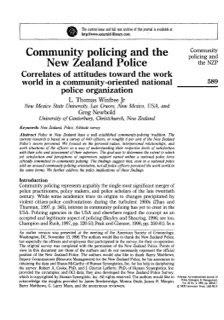By: KENT R. KERLEY & MICHAEL L. BENSON
Advocates of community-oriented policing contend that it has great potential to reduce crime and fear because it strengthens community social organization and cohesion. Previous studies of community policing, however, fail to include community process variables as outcome measures and instead focus on outcome measures such as crime rates and fear of crime. Despite the recent focus by criminologists on community context in general studies of crime and delinquency, no direct attempt has been made to investigate the potential relationship between community policing and broader community processes such as community organization, cohesion, and cooperative security. Using data from a comprehensive community policing study conducted in Oakland, California, and Birmingham, Alabama, from 1987 to 1989, this article investigates whether community policing strategies have effects on community processes. Findings indicate that community policing tactics do not have strong effects on community processes. These results may help explain why community policing has so far had little measurable impact on crime and fear of crime, and may be instructive for the design and evaluation of future community policing studies.
POLICE QUARTERLY Vol. 3 No. 1, March 2000 46–69





















